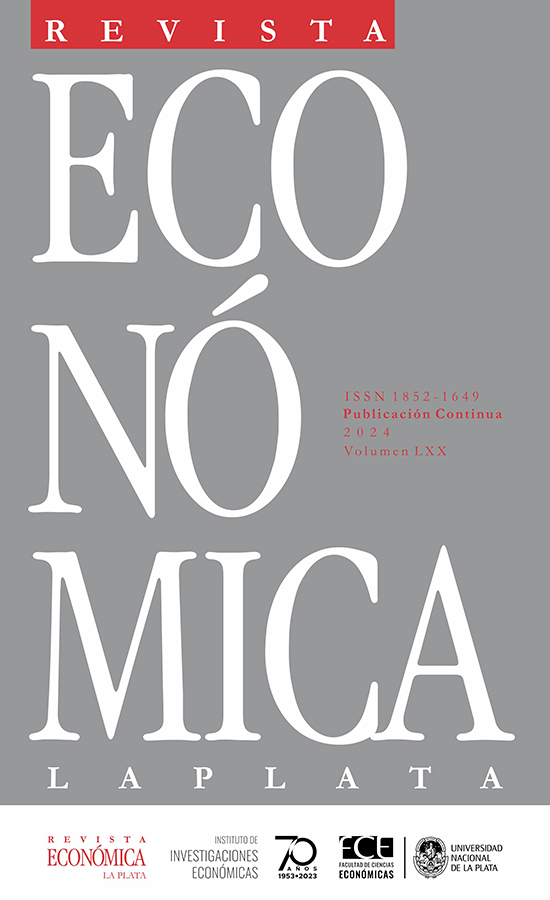Management practices and innovation: Their relationship with the performance and employment of Argentine firms
DOI:
https://doi.org/10.24215/18521649e035Keywords:
Argentina, innovation, productivity, employment, wage, management capacityAbstract
Drawing on firm-level data, this research delves into the interplay among management practices, innovation, and the performance of Argentine firms. The findings reveal that management practices exhibit heterogeneity across firms and industries, showing a positive correlation with revenue, exports, and labor market metrics. Firms adopting advanced management practices are associated with a higher likelihood of innovating (extensive margin) and the magnitude of investment in innovation (intensive margin). Additionally, are more likely to yield outcomes in the innovation process.
Downloads
Metrics
References
Adams, R., Bessant, J. y Phelps, R. (2006). Innovation management measurement: A review. International Journal of Management Reviews, 8(1), 21-47. https://doi.org/10.1111/j.1468-2370.2006.00119.x
Artopoulos, A., Friel, D. y Hallak, J. C. (2013). Export emergence of differentiated goods from developing countries: Export pioneers and business practices in Argentina. Journal of Development Economics, 105, 19-35. https://doi.org/10.1016/j.jdeveco.2013.07.001
Arza, V., Cirera, X., López, E. y Colonna, A. (2023). Explaining differences in the returns to R&D in Argentina: The role of contextual factors. Economics of Innovation and New Technology, 32(6), 751-782. http://hdl.handle.net/11336/168995
Barletta, F., Pereira, M., Suárez, D. y Yoguel, G. (2017). Construcción de capacidades en las firmas argentinas. Más allá de los laboratorios de I+D. Pymes, Innovación y Desarrollo, 4(3), 39–56. https://revistas.unc.edu.ar/index.php/pid/article/view/16880
Barletta, F., Pereira, M., Suárez, D. y Yoguel, G. (2017). Perfil de I+ D en firmas industriales argentinas: la necesidad de construir capacidades. En Comisión Económica para América Latina y el Caribe (Ed.), La Encuesta Nacional de Dinámica de Empleo e Innovación (ENDEI) como herramienta de análisis: la innovación y el empleo en la industria manufacturera argentina (pp. 81-96). Publicaciones de Naciones Unidas. https://hdl.handle.net/11362/44133
Bartz-Zuccala, W., Mohnen, P. y Schweiger, H. (2018). The role of innovation and management practices in determining firm productivity. Comparative Economic Studies, 60, 502-530. https://doi.org/10.1057/s41294-018-0075-3
Brambilla, I. y Peñaloza Pacheco, L. (2018). Exportaciones, Salarios e Innovación Tecnológica. Evidencia para Argentina. Económica, 64, 5–21. https://doi.org/10.24215/18521649e002
Bender, S., Bloom, N., Card, D., Van Reenen, J. y Wolter, S. (2018). Management practices, workforce selection, and productivity. Journal of Labor Economics, 36(S1), S371-S409. https://doi.org/10.3386/w22101
Bloom, N. y Van Reenen, J. (2007). Measuring and explaining management practices across firms and countries. The Quarterly Journal of Economics, 122(4), 1351-1408. http://doi.org/10.1162/qjec.2007.122.4.1351
Bloom, N. y Van Reenen, J. (2010). Why do management practices differ across firms and countries? Journal of Economic Perspectives, 24(1), 203-224. http://doi.org/10.1257/jep.24.1.203
Bloom, N., Brynjolfsson, E., Foster, L., Jarmin, R., Patnaik, M., Saporta-Eksten, I. y Van Reenen, J. (2019). What drives differences in management practices? American Economic Review, 109(5), 1648-1683. http://doi.org/10.1257/aer.20170491
Bloom, N., Eifert, B., Mahajan, A., McKenzie, D. y Roberts, J. (2013). Does management matter? Evidence from India. The Quarterly Journal of Economics, 128(1), 1-51. http://doi.org/10.1093/qje/qjs044
Bloom, N., Sadun, R. y Van Reenen, J. (2016). Management as a Technology? [Documento de trabajo No. w22327]. National Bureau of Economic Research. http://doi.org/10.3386/w22327
Bruhn, M., Karlan, D. y Schoar, A. (2018). The impact of consulting services on small and medium enterprises: Evidence from a randomized trial in Mexico. Journal of Political Economy, 126(2), 635-687. http://doi.org/10.1086/696154
Caruso, G., Sosa‐Escudero, W. y Svarc, M. (2015). Deprivation and the dimensionality of welfare: a variable‐selection cluster‐analysis approach. Review of Income and Wealth, 61(4), 702-722. http://dx.doi.org/10.1111/roiw.12127
Cirera, X. y Maloney, W. F. (2017). The innovation paradox: Developing-country capabilities and the unrealized promise of technological catch-up. World Bank Publications. http://doi.org/10.1596/978-1-4648-1160-9
Galasso, A. y Simcoe, T. S. (2011). CEO overconfidence and innovation. Management Science, 57(8), 1469-1484. http://doi.org/10.1287/mnsc.1110.1374
Gifi, A. (1990). Nonlinear multivariate analysis. Wiley.
Garone, L. F., Villalba, P. A. L., Maffioli, A. y Ruzzier, C. A. (2020). Firm-level productivity in Latin America and the Caribbean. Research in Economics, 74(2), 186-192. http://doi.org/10.1016/j.rie.2020.04.004
Iacovone, L., Pereira-Lopez, M. y Schiffbauer, M. (2017). ICT use, competitive pressures, and firm performance in Mexico. The World Bank Economic Review, 30 (Supplement_1), S109-S118. http://doi.org/10.1093/wber/lhw023
Kremp, E. y Mairesse, J. (2004). Knowledge management, innovation, and productivity: a firm level exploration based on French manufacturing CIS3 data. [Documento de Trabajo N° w10237]. National Bureau of Economic Research. http://doi.org/10.3386/w10237
Mair, P. y de Leeuw, J. (2010). Scaling variables by optimizing correlational and non-correlational aspects in R. Journal of Statistical Software, 32(9).
Martinez Correa, J. y Pereira, M. (2018). Las capacidades de las firmas argentinas: una aproximación con análisis de cluster [Ponencia]. LIII Reunión Anual. Asociación Argentina de Economía Política.
McKenzie, D. y Woodruff, C. (2017). Business practices in small firms in developing countries. Management Science, 63(9), 2967-2981. https://doi.org/10.1287/mnsc.2016.2492
Merola, G. M. y Baulch, B. (2019). Using sparse categorical principal components to estimate asset indices: New methods with an application to rural Southeast Asia. Review of Development Economics, 23(2), 640-662. http://doi.org/10.1111/rode.12568
Michailidis, G. y de Leeuw, J. (1998). The Gifi system of descriptive multivariate analysis. Statistical Science, 13, 307–336. http://doi.org/10.1214/ss/1028905828
Pisano, G. y Teece, D. (1994). The dynamic capabilities of firms: an introduction. Industrial and Corporate Change, 3(3), 537-556. http://doi.org/10.1093/icc/3.3.537-a
Rammer, C., Czarnitzki, D. y Spielkamp, A. (2009). Innovation success of non-R&D-performers: Substituting technology by management in SMEs. Small Business Economics, 33, 35-58. http://doi.org/10.2139/ssrn.1314246
Sutton, J. y Kpentey, B. (2012). An enterprise map of Ghana. (Vol. 2). International Growth Centre in association with the London Publishing Partnership.
Published
How to Cite
Issue
Section
License
Copyright (c) 2024 Victoria Anauati

This work is licensed under a Creative Commons Attribution-NonCommercial-NoDerivatives 4.0 International License.
The material published in the journal is distributed under a Creative Commons Attribution-NonCommercial-NoDerivatives 4.0 International (CC BY-NC-ND 4.0) license. This license requires proper credit to be given, a link to the license to be provided, and changes to be indicated. It does not permit commercial use of the work, and if the work is remixed, transformed, or otherwise modified, distribution of such modification is not allowed.






























